Biotech and Digitalisation
< RFC >
Masterclass: Inputs on Biotech and Digitalisation.
by pauline.vierne@gmail.com +49 176 2265 9849
https://pauline-vierne.squarespace.com/
* Presentation (about 30/45 min)
* Hands-on - "sonic 555" workshop (about 2h)
Revisions:
201806xx start
20180619 masterclass @Institut Néerlandais, Paris
20190706 fixed broken links for images
20210613 linked from 🔗hypertextile
20220109 →RFC
Table of Contents
| 1 | Proposal |
| 2 | EUROPEAN FUNDINGS |
| 3 | TERMS / NOTIONS |
| 3.1 | * DIGITALIZATION / DIGITIZATION |
| 3.2 | * SUSTAINABILITY |
| 3.3 | * BIOMIMETICS / BIOMIMICRY / BIONICS |
| 4 | PROJECT EXAMPLES |
| 4.1 | * DIGITALIZATION & SUSTAINABILTY IN FASHION |
| 4.1.1 | ZYSE.me |
| 4.1.2 | Solemaker |
| 4.1.3 | HILO |
| 4.1.4 | Air Guru |
| 4.2 | * BIOFABRICATION |
| 4.2.1 | Biofabricate |
| 4.2.2 | Futurecraft by Adidas |
| 4.2.3 | Mycotex |
| 4.2.4 | Future Flora |
| 4.2.5 | Bioshades |
| 4.2.6 | Biogarmentry |
| 4.3 | * EXPERIMENTAL LIVING (and researching) |
| 4.3.1 | Svenja Keune |
| 4.3.2 | CHT & HACKBASES |
| 4.4 | * FICTIONS & SPECULATIONS // HUMAN-NATURE INTERFACES |
| 4.4.1 | La Mère |
| 4.4.2 | Human Nature |
| 4.4.3 | Cyborganics |
| 5 | OTHERS |
| 5.1 | RADICAL MATTERS |
| 6 | ********* PAD ******** |
¶Proposal
'' Fashion Tech asks for sustainability ''
Soft circuitry, flexible electronics and biotechnology open a wide range of possibilities for fashion, be it by giving way to new functions to empower us or allowing for unconventional self expression in dress. Fashion tech, going along with the digitalisation of everyday life and the training of super artificial intelligence, promises to change our near future, and already shows significant impact.
Despite the announced increase of production efficency and added value for humanity, a major concern arises, questioning the sustainabiliy of a discipline merging two of the most polluting industries worldwide. As our environmental awareness arises, biology and the potential of natural materials, raw as well as modified, inspire innovative concepts for fashion and industry.
Addressing this, we will provide an overview of current initiatives and projects that promote open channels, local production, craftsmanship approaches, social inclusion and education.
**********
'' Fashion Tech asks for sustainability ''
Soft circuitry, flexible electronics and biotechnology open a wide range of possibilities for fashion, be it by giving way to new functions to empower us or allowing for unconventional self expression in dress. Fashion tech, going along with the digitalisation of everyday life and the training of super artificial intelligence, promises to change our near future, and already shows significant impact.
Despite the announced increase of production efficency and added value for humanity, a major concern arises, questioning the sustainabiliy of a discipline merging two of the most polluting industries worldwide. As our environmental awareness arises, biology and the potential of natural materials, raw as well as modified, inspire innovative concepts for fashion and industry.
Addressing this, we will provide an overview of current initiatives and projects that promote open channels, local production, craftsmanship approaches, social inclusion and education.
**********
¶EUROPEAN FUNDINGS
* http://www.arcintexetn.eu/
PhD programme for more sustainable forms of living, connecting architecture, interaction design and textiles.
* https://wearsustain.eu/ Ethical wearables, electronic and smart textiles network
Ethical wearables, electronic and smart textiles network
* http://www.worthproject.eu/
* https://www.digital.tu-berlin.de/menue/startseite/digital
PhD programme for women researchers and artists in digitalization (TU Berlin)
**********
* http://www.arcintexetn.eu/

PhD programme for more sustainable forms of living, connecting architecture, interaction design and textiles.
* https://wearsustain.eu/
 Ethical wearables, electronic and smart textiles network
Ethical wearables, electronic and smart textiles network* http://www.worthproject.eu/

* https://www.digital.tu-berlin.de/menue/startseite/digital

PhD programme for women researchers and artists in digitalization (TU Berlin)
**********
¶ * DIGITALIZATION / DIGITIZATION
wikipedia
" The term digitization is often used when diverse forms of information, such as an object, text, sound, image or voice, are converted into a single binary code. The core of the process is the compromise between the capturing device and the player device so that the rendered result represents the original source with the most possible fidelity, and the advantage of digitization is the speed and accuracy in which this form of information can be transmitted with no degradation compared with analog information.
Digital information exists as one of two digits, either 0 or 1. These are known as bits (a contraction of `binary digits´) and the sequences of 0s and 1s that constitute information are called bytes.
(...)
The broad use of internet and the increasing popularity of lean philosophy has also increased the use and meaning of `digitizing´ to describe improvements in the efficiency of organizational processes.
Lean philosophy refers to the approach which considers any use of time and resources, which does not lead directly to creating a product, as waste and therefore a target for elimination. This will often involve some kind of Lean process in order to simplify process activities, with the aim of implementing new "lean and mean" processes by digitizing data and activities. Digitization can help to eliminate time waste by introducing wider access to data, or by implementation of enterprise resource planning systems. "
**********
wikipedia
" The term digitization is often used when diverse forms of information, such as an object, text, sound, image or voice, are converted into a single binary code. The core of the process is the compromise between the capturing device and the player device so that the rendered result represents the original source with the most possible fidelity, and the advantage of digitization is the speed and accuracy in which this form of information can be transmitted with no degradation compared with analog information.
Digital information exists as one of two digits, either 0 or 1. These are known as bits (a contraction of `binary digits´) and the sequences of 0s and 1s that constitute information are called bytes.
(...)
The broad use of internet and the increasing popularity of lean philosophy has also increased the use and meaning of `digitizing´ to describe improvements in the efficiency of organizational processes.
Lean philosophy refers to the approach which considers any use of time and resources, which does not lead directly to creating a product, as waste and therefore a target for elimination. This will often involve some kind of Lean process in order to simplify process activities, with the aim of implementing new "lean and mean" processes by digitizing data and activities. Digitization can help to eliminate time waste by introducing wider access to data, or by implementation of enterprise resource planning systems. "
**********
¶ * SUSTAINABILITY
wikipedia
" Sustainability is the process of change, in which the exploitation of resources, the direction of investments, the orientation of technological development and institutional change are all in harmony and enhance both current and future potential to meet human needs and aspirations.
The organizing principle for sustainability is sustainable development, which includes the following interconnected domains: environment, economic and social. Sub-domains of sustainable development have been considered also: cultural, technological and political. Sustainable development, is the development that meets the needs of the present without compromising the ability of future generations to meet their own needs. Brundtland Report for the World Commission on Environment and Development (1992) introduced the term of sustainable development.
Sustainability can also be defined as a socio-ecological process characterized by the pursuit of a common ideal.
An ideal is by definition unattainable in a given time and space. However, by persistently and dynamically approaching it, the process results in a sustainable system. "
**********
wikipedia
" Sustainability is the process of change, in which the exploitation of resources, the direction of investments, the orientation of technological development and institutional change are all in harmony and enhance both current and future potential to meet human needs and aspirations.
The organizing principle for sustainability is sustainable development, which includes the following interconnected domains: environment, economic and social. Sub-domains of sustainable development have been considered also: cultural, technological and political. Sustainable development, is the development that meets the needs of the present without compromising the ability of future generations to meet their own needs. Brundtland Report for the World Commission on Environment and Development (1992) introduced the term of sustainable development.
Sustainability can also be defined as a socio-ecological process characterized by the pursuit of a common ideal.
An ideal is by definition unattainable in a given time and space. However, by persistently and dynamically approaching it, the process results in a sustainable system. "
**********
¶ * BIOMIMETICS / BIOMIMICRY / BIONICS
wikipedia
" Biomimetics or biomimicry is the imitation of the models, systems, and elements of nature for the purpose of solving complex human problems. A closely related field is bionics or biologially inspired engineering.
Living organisms have evolved well-adapted structures and materials over geological time through natural selection. Biomimetics has given rise to new technologies inspired by biological solutions at macro and nanoscales. Humans have looked at nature for answers to problems throughout our existence. Nature has solved engineering problems such as self-healing abilities, environmental exposure tolerance and resistance, hydrophobicity, self-assembly, and harnessing solar energy. "
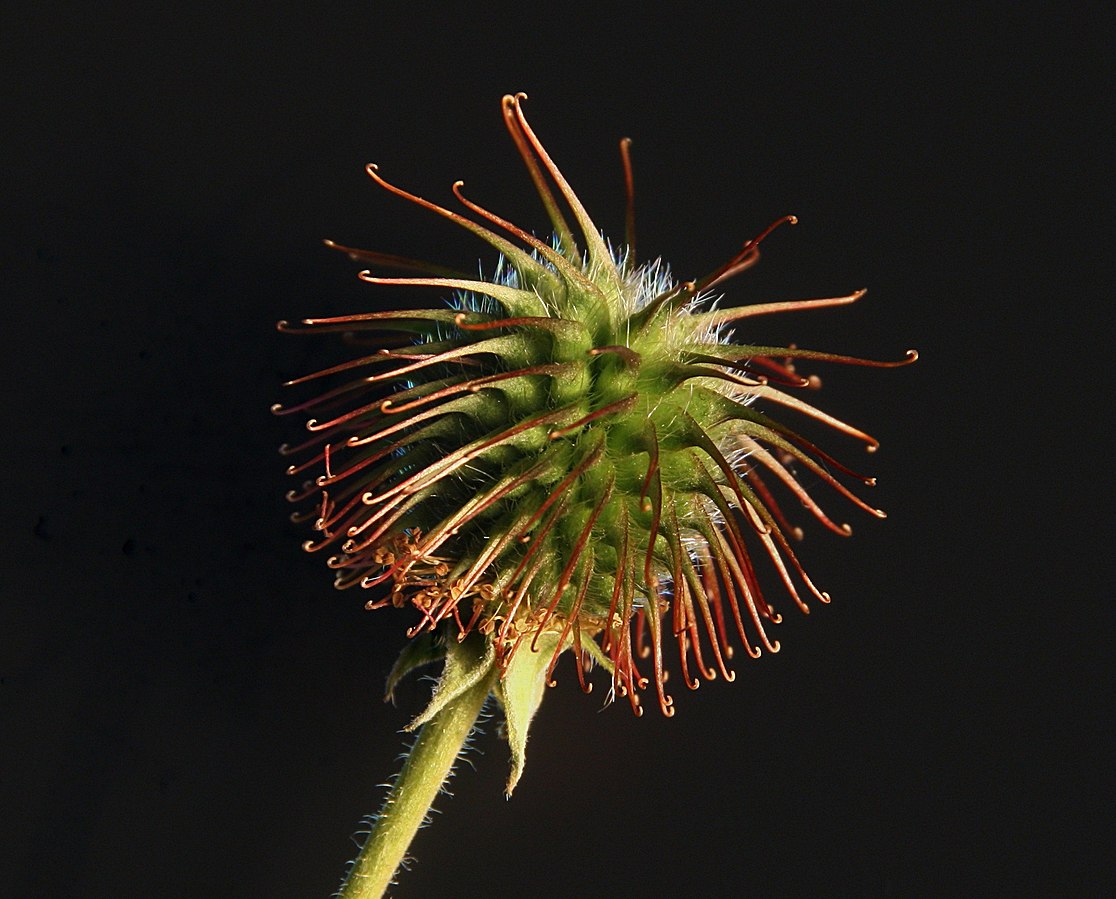

**********
wikipedia
" Biomimetics or biomimicry is the imitation of the models, systems, and elements of nature for the purpose of solving complex human problems. A closely related field is bionics or biologially inspired engineering.
Living organisms have evolved well-adapted structures and materials over geological time through natural selection. Biomimetics has given rise to new technologies inspired by biological solutions at macro and nanoscales. Humans have looked at nature for answers to problems throughout our existence. Nature has solved engineering problems such as self-healing abilities, environmental exposure tolerance and resistance, hydrophobicity, self-assembly, and harnessing solar energy. "


**********
¶ * DIGITALIZATION & SUSTAINABILTY IN FASHION
* Personalization * Smart Services * Local Production * Parametric Design *
https://fashionunited.uk/news/fashion/the-case-for-digitization-global-supply-chain-practices-in-the-fashion-industry/2017101126238
* Smart services as in SERVICE FACTORY
Research Project funded by the German Ministry of Economy and Energy, lead by Adidas
" Ziel des Projekts SERVICEFACTORY ist die Konzeption, exemplarische Umsetzung und Validierung einer Online-Plattform für die Erfassung, Übermittlung und Analyse von personenspezifischen Daten, die von Sensoren in Alltagsgegenständen (z. B. Wearables, Sportschuhe, Smart Watches etc.) erhoben werden. Aus den so aggregierten Nutzungsdaten sollen kundenindividuelle Smart Services in Form von Dienstleistungen für Sport und Gesundheit entwickelt werden. "
" Parametric design is a process based on algorithmic thinking that enables the expression of parameters and rules that, together, define, encode and clarify the relationship between design intent and design response.
Parametric design is a paradigm in design where the relationship between elements is used to manipulate and inform the design of complex geometries and structures.
The term "parametric" originates from mathematics (parametric equation) and refers to the use of certain parameters or variables that can be edited to manipulate or alter the end result of an equation or system. While today the term is used in reference to computational design systems, there are precedents for these modern systems in the works of architects such as Antoni Gaudí, who used analog models to explore design space. "
other example: https://network.wearsustain.eu/actors/AWGkdmF_5CMOeXhOH_ws
**********
* Personalization * Smart Services * Local Production * Parametric Design *
" Parametric design is a process based on algorithmic thinking that enables the expression of parameters and rules that, together, define, encode and clarify the relationship between design intent and design response.
Parametric design is a paradigm in design where the relationship between elements is used to manipulate and inform the design of complex geometries and structures.
The term "parametric" originates from mathematics (parametric equation) and refers to the use of certain parameters or variables that can be edited to manipulate or alter the end result of an equation or system. While today the term is used in reference to computational design systems, there are precedents for these modern systems in the works of architects such as Antoni Gaudí, who used analog models to explore design space. "
**********
¶ ZYSE.me - Custom-sized clothing, on demand -
https://www.zyse.me/
" ZYSE™ is an AI technology platform that offers consumers unique products, and empowers fashion brands to sell and produce personalized clothing on demand.
Together with innovative brands and manufacturers we are reinventing the fashion value chain, leading the path to a sustainable future of fashion. "

**********
https://www.zyse.me/
" ZYSE™ is an AI technology platform that offers consumers unique products, and empowers fashion brands to sell and produce personalized clothing on demand.
Together with innovative brands and manufacturers we are reinventing the fashion value chain, leading the path to a sustainable future of fashion. "

**********
¶ Solemaker - A platform for creating a new way to think about shoes -
https://arcintexetn.com/2016/11/01/solemaker/ https://solemaker.io/ deprecated ???
" Starting from a scan, the wearers information is encoded into the online design software. The wearer chooses from a parametric shoe model designed by one of today’s top young shoe designer.
The generative shoe software brings the scan along with sensor data from the user to algorithmically create a shoe for the specific wearer. This shoe is ultra personalised to the wearer using parameters such as foot shape, pressure density and kinetic movement.
The shoe is then materialised using digital manufacturing techniques and a wearable sensing system is added to the shoe. A profile of expected use is created for the wearer based upon need and style. As the shoe is worn, a wearable sensing system periodically activates to measure use and movement. At the end of life, the shoe is sent back so that the materials and sensor can be recycled up to twenty times. "


**********
https://arcintexetn.com/2016/11/01/solemaker/
" Starting from a scan, the wearers information is encoded into the online design software. The wearer chooses from a parametric shoe model designed by one of today’s top young shoe designer.
The generative shoe software brings the scan along with sensor data from the user to algorithmically create a shoe for the specific wearer. This shoe is ultra personalised to the wearer using parameters such as foot shape, pressure density and kinetic movement.
The shoe is then materialised using digital manufacturing techniques and a wearable sensing system is added to the shoe. A profile of expected use is created for the wearer based upon need and style. As the shoe is worn, a wearable sensing system periodically activates to measure use and movement. At the end of life, the shoe is sent back so that the materials and sensor can be recycled up to twenty times. "


**********
¶ HILO
https://www.studiohilo.com/
" HILO is a platform to challenge the process of yarn production in the same way 3D printers are revolutionising manufacturing.
At the core of HILO is a spinning machine for local production and e-textile research which enables the user to determine properties of a textile from the very beginning of its production process: the yarn spinning. Through a friendly software interface users can design and produce their own yarn in a efficient, individualised and sustainable way. "


**********
https://www.studiohilo.com/
" HILO is a platform to challenge the process of yarn production in the same way 3D printers are revolutionising manufacturing.
At the core of HILO is a spinning machine for local production and e-textile research which enables the user to determine properties of a textile from the very beginning of its production process: the yarn spinning. Through a friendly software interface users can design and produce their own yarn in a efficient, individualised and sustainable way. "

**********
¶ Air Guru - health care, sustainability, comfort, technology, social impact -
https://network.wearsustain.eu/actors/AWGkdc6B5CMOeXhOH_wa#
" The first Air Guru project is the realization of a filtering scarf made by textile waste, transformed through nanotechnologies in a filtering textile.
Our prototype combines technology and design to create a new product willing to support human beings in protecting their respiratory systems from pollution. As of high-end techniques, people not only will want to use it as a functional garment but also as a fashionable accessory.
The Air Guru business project is designed to develop in a sustainable way and to reach Equilibrium. Its business model comes from the social innovation combining the principles of Circular Economy, Social Responsibility, the reuse-reduce-recycle rule, the triple and quadruple bottom-line approach. Wherever there is textile waste Air Guru can constitute branches working locally and sensitizing/educating customers toward responsible consumption. Economic sustainability has been an asset in planning Air Guru development. We base our business development on zero cost raw material, on already existing technologies provided by a business partner, a marketing strategy based on social responsibility, innovation and health protection.
still existing ?
**********
https://network.wearsustain.eu/actors/AWGkdc6B5CMOeXhOH_wa#
" The first Air Guru project is the realization of a filtering scarf made by textile waste, transformed through nanotechnologies in a filtering textile.
Our prototype combines technology and design to create a new product willing to support human beings in protecting their respiratory systems from pollution. As of high-end techniques, people not only will want to use it as a functional garment but also as a fashionable accessory.
The Air Guru business project is designed to develop in a sustainable way and to reach Equilibrium. Its business model comes from the social innovation combining the principles of Circular Economy, Social Responsibility, the reuse-reduce-recycle rule, the triple and quadruple bottom-line approach. Wherever there is textile waste Air Guru can constitute branches working locally and sensitizing/educating customers toward responsible consumption. Economic sustainability has been an asset in planning Air Guru development. We base our business development on zero cost raw material, on already existing technologies provided by a business partner, a marketing strategy based on social responsibility, innovation and health protection.
**********
¶ * BIOFABRICATION
" Biofabrication is designing and building products with biology. Harnessing organisms such as bacteria, yeast, algae, mycelium, mammalian cells, to cultivate consumer goods as varied as footwear and furniture to fashion and food. "
Biofabrication is making biological materials using living cells.
" Biofabrication is designing and building products with biology. Harnessing organisms such as bacteria, yeast, algae, mycelium, mammalian cells, to cultivate consumer goods as varied as footwear and furniture to fashion and food. "
Biofabrication is making biological materials using living cells.
¶ Biofabricate, founded in 2013 by pioneer Suzanne Lee
https://www.biofabricate.co/
https://www.gameplan-a.com/2016/12/suzanne-lee-biofabricate-growing-better-future/

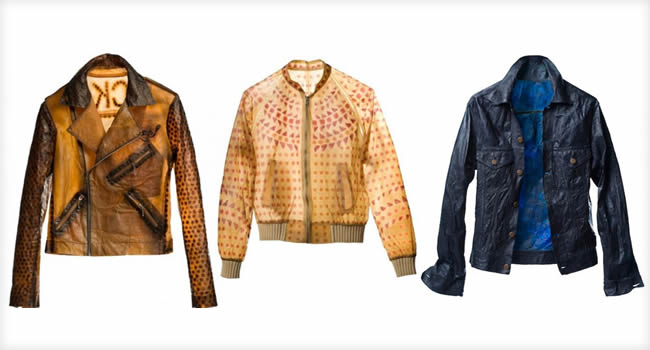
**********
https://www.biofabricate.co/


**********
¶ Futurecraft by Adidas - Biofabric shoe -
https://www.adidas.fr/futurecraft
" Bacteria is being used as the factories to produce silk biopolymers which are then purified and spun into yarn for the upper of the adidas shoe.
So, biofabrication enables us to commercially produce new materials created with the building blocks of nature but designed and engineered to have programmable performance properties, all produced in a far more resource-efficient way which is potentially a huge win for the planet. "

**********
https://www.adidas.fr/futurecraft
" Bacteria is being used as the factories to produce silk biopolymers which are then purified and spun into yarn for the upper of the adidas shoe.
So, biofabrication enables us to commercially produce new materials created with the building blocks of nature but designed and engineered to have programmable performance properties, all produced in a far more resource-efficient way which is potentially a huge win for the planet. "

**********
¶ Mycotex by NEFFA
https://neffa.nl/portfolio/mycotex-prototype
" We live in a world of Fast Fashion and Disposable clothing and most people think that is a disaster. They are working on recycling and circular fashion. So they are trying to change the behaviour of 7 billion people, which is a very difficult task. NEFFA thinks Fast Fashion and Disposable clothing represents an incredible opportunity. We have an entire generation of people who now expect to own a garment for a year, maybe two, before disposing it and buying something new. With the right type of materials they can be custom-designed to meet that life cycle. We have the potential to serve that market and to do so in a sustainable way. We need solutions that respond to the reality that we live in.
MycoTEX is a 100% biodegradable material based on mycelium, the root of mushrooms.
We have developed a technology and technique to create a sustainable fabric. We made a proof-of-concept with the material and the 3D modelling process and developed a catwalk ready prototype for the Dutch Sustainable Fashion Week. With this we generated a lot of buzz and excitement all over the world, not only in the science and fashion industry, but also amongst consumers. "

Winner of Global Change Award, an innovation challenge by H&M consious foundation > video
**********
https://neffa.nl/portfolio/mycotex-prototype
" We live in a world of Fast Fashion and Disposable clothing and most people think that is a disaster. They are working on recycling and circular fashion. So they are trying to change the behaviour of 7 billion people, which is a very difficult task. NEFFA thinks Fast Fashion and Disposable clothing represents an incredible opportunity. We have an entire generation of people who now expect to own a garment for a year, maybe two, before disposing it and buying something new. With the right type of materials they can be custom-designed to meet that life cycle. We have the potential to serve that market and to do so in a sustainable way. We need solutions that respond to the reality that we live in.
MycoTEX is a 100% biodegradable material based on mycelium, the root of mushrooms.
We have developed a technology and technique to create a sustainable fabric. We made a proof-of-concept with the material and the 3D modelling process and developed a catwalk ready prototype for the Dutch Sustainable Fashion Week. With this we generated a lot of buzz and excitement all over the world, not only in the science and fashion industry, but also amongst consumers. "

Winner of Global Change Award, an innovation challenge by H&M consious foundation > video
**********
¶ Future Flora by Giulia Tomasello
https://gitomasello.com/Future-Flora
" The human body is composed for the 90% of different microorganisms, most of which are beneficial to their host.
Microbes as bacteria, fungi and viruses are part of our skin flora, covering both the inside and the outer surface of our body. Even though invisible to our eyes, our microflora has a symbiotic relationship with the interface between our body and the environment - our skin.
Flora aims to incentive this symbiotic relationship that raises the beneficial presence of microbes and bacteria in the human body. This proposal uses techniques of microencapsulation of targeted bacteria in a non-woven fabric making it possible to wear the probiotics that keep our body healthy. Creating scaffolds for the exponential bacterial growth in appropriate areas of the body, our clothes and accessories become the ecosystem that balance and support our skin flora. "



Winner of Starts Prize 2018: Grand Prize – Artistic Exploration
Awarded for artistic exploration and art works where appropriation by the arts has a strong potential to influence or alter the use, deployment or perception of technology.
**********
https://gitomasello.com/Future-Flora
" The human body is composed for the 90% of different microorganisms, most of which are beneficial to their host.
Microbes as bacteria, fungi and viruses are part of our skin flora, covering both the inside and the outer surface of our body. Even though invisible to our eyes, our microflora has a symbiotic relationship with the interface between our body and the environment - our skin.
Flora aims to incentive this symbiotic relationship that raises the beneficial presence of microbes and bacteria in the human body. This proposal uses techniques of microencapsulation of targeted bacteria in a non-woven fabric making it possible to wear the probiotics that keep our body healthy. Creating scaffolds for the exponential bacterial growth in appropriate areas of the body, our clothes and accessories become the ecosystem that balance and support our skin flora. "



Winner of Starts Prize 2018: Grand Prize – Artistic Exploration
Awarded for artistic exploration and art works where appropriation by the arts has a strong potential to influence or alter the use, deployment or perception of technology.
**********
¶ Bioshades at TextileLab Amsterdam - Waag - dyeing with bacteria
https://fabtextiles.org/tag/bacteria-textile-dyeing/
https://labs.tcbl.eu/projects/2
" Could dyeing with bacteria be an alternative to chemical dyes? With BioShades we explore the potential of dyeing with bacteria as a less harmful alternative?
(...)
We explore new ways to design, make, and work together and inventing new business models to open up new markets. "
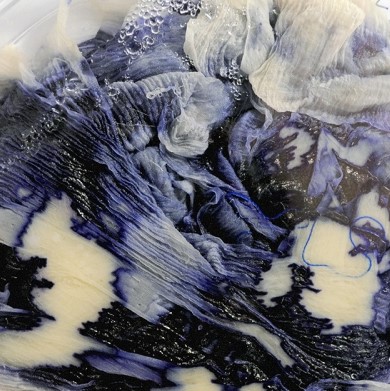
**********
https://fabtextiles.org/tag/bacteria-textile-dyeing/
https://labs.tcbl.eu/projects/2
" Could dyeing with bacteria be an alternative to chemical dyes? With BioShades we explore the potential of dyeing with bacteria as a less harmful alternative?
(...)
We explore new ways to design, make, and work together and inventing new business models to open up new markets. "

**********
¶ Biogarmentry
https://www.madisonsinnovative.com/blog/2018/10/31/biogarmentry
" Living, photosynthesizing, and compostable textiles. intersection of design+biology to envision possibilities for future of textiles. "

also https://www.instagram.com/biogarmentry/
**********
https://www.madisonsinnovative.com/blog/2018/10/31/biogarmentry
" Living, photosynthesizing, and compostable textiles. intersection of design+biology to envision possibilities for future of textiles. "

also https://www.instagram.com/biogarmentry/
**********
¶ Svenja Keune - on textile farming: seeds as material for textile design -


Abstract: Presently, designing with living systems such as insects, fungi and bacteria has become an area of extended interest, proposing collaborative processes of designing and manufacturing - as a solution for symbiotic ways of living. On the scale of the interior, modern systems for interior gardening, combining both functional, e.g., food supply, purifying the air, and aesthetic values, experience exceptional popularity, ensuring a complementary perspective on horticultural landscapes indoors. As a result, the spaces where people live and crops grow increasingly intersect and therefore open up for developments that bridge both areas and where aesthetic perspectives become equally important. However, modern indoor gardening systems are shaped by commercial horticultural practices, bringing reservoirs such as buckets, tubs or tanks, mostly built of plastic, into the homes. Textile Farming aims to explore alternative forms of plant organisation by blending seeds and textile structures into a hybrid material for textile interior scenarios. Consequently the materials’ performative capacity becomes part of the textile design process. A foundational part are forms of human management, e.g. activation of the seeds, maintenance of the plants, interaction with the hybrid textile structures within and beyond interiors, that leads to experiences and expressions. By practice based design research and through a series of design examples that explore the transformative potential of seeds in textile structures, alternative forms of plant organisation and methods for the textile design process lead to scenarios that propose alternatives to how we live with and organise plants today.
_her experimental tiny- and green houses!


**********
Abstract: Presently, designing with living systems such as insects, fungi and bacteria has become an area of extended interest, proposing collaborative processes of designing and manufacturing - as a solution for symbiotic ways of living. On the scale of the interior, modern systems for interior gardening, combining both functional, e.g., food supply, purifying the air, and aesthetic values, experience exceptional popularity, ensuring a complementary perspective on horticultural landscapes indoors. As a result, the spaces where people live and crops grow increasingly intersect and therefore open up for developments that bridge both areas and where aesthetic perspectives become equally important. However, modern indoor gardening systems are shaped by commercial horticultural practices, bringing reservoirs such as buckets, tubs or tanks, mostly built of plastic, into the homes. Textile Farming aims to explore alternative forms of plant organisation by blending seeds and textile structures into a hybrid material for textile interior scenarios. Consequently the materials’ performative capacity becomes part of the textile design process. A foundational part are forms of human management, e.g. activation of the seeds, maintenance of the plants, interaction with the hybrid textile structures within and beyond interiors, that leads to experiences and expressions. By practice based design research and through a series of design examples that explore the transformative potential of seeds in textile structures, alternative forms of plant organisation and methods for the textile design process lead to scenarios that propose alternatives to how we live with and organise plants today.
_her experimental tiny- and green houses!
**********
¶ CHT & HACKBASES
https://totalism.org/
"""
This hackbase is an infrastructure project designing and deploying a free living habitat.
A recipe for, and an actual place, where you can live-in for almost free, any time you want, and organise a new and completely different lifestyle around.
Hackbases are live-in hackerspaces, the critically missing infrastructure to enable full-time vanguard lifestyles for technologists, theorists, artists, activists, ... - for hackers.
"""
This hackbase began as "Cyberhippietotalism" or "CHT#1" in 2011. After 3 years as a rented house, the second version of the base restarted in November 2014, as an experimental off-grid habitat research initiative, scheming to buy first plot of land and settle in the same area: North of Lanzarote, Canary Islands. A serie of experimental living situation/camps have been performed since the 2014/2015 season. "
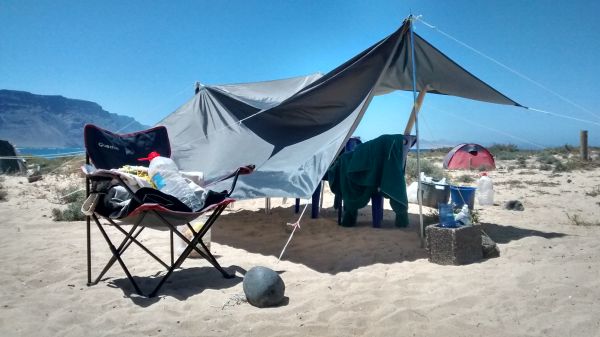
**********
https://totalism.org/
"""
This hackbase is an infrastructure project designing and deploying a free living habitat.
A recipe for, and an actual place, where you can live-in for almost free, any time you want, and organise a new and completely different lifestyle around.
Hackbases are live-in hackerspaces, the critically missing infrastructure to enable full-time vanguard lifestyles for technologists, theorists, artists, activists, ... - for hackers.
"""
This hackbase began as "Cyberhippietotalism" or "CHT#1" in 2011. After 3 years as a rented house, the second version of the base restarted in November 2014, as an experimental off-grid habitat research initiative, scheming to buy first plot of land and settle in the same area: North of Lanzarote, Canary Islands. A serie of experimental living situation/camps have been performed since the 2014/2015 season. "

**********
¶ La Mère - performance by the Harvesting group at Etextile Summercamp 2016 -
http://etextile-summercamp.org/2016/harvesting-textile/
" Over the period of 4 days we developed samples of new materials combining textile techniques, technology and nature.
We grew crystals, cooked bioplastics with maizena and/or agar with food colouring. We crushed eggshells and mixed them with glow in the dark pigments. We made bioplastics from banana peels. We made aquafaba meringues with LEDs. We made paper with beetroot peels and grass. We made weavings from seeds and knitted fabric and did crochet with bamboo and wool. We wove seaweed and grass into fabrics. We made all kinds of kombuchas with electronics and dyes. Kombucha was woven, knitted, printed and embroidered. We screenprinted fabrics with onions, banana and carrots. We made soft robotics with nitinol and we foraged big fungi. "


**********
http://etextile-summercamp.org/2016/harvesting-textile/
" Over the period of 4 days we developed samples of new materials combining textile techniques, technology and nature.
We grew crystals, cooked bioplastics with maizena and/or agar with food colouring. We crushed eggshells and mixed them with glow in the dark pigments. We made bioplastics from banana peels. We made aquafaba meringues with LEDs. We made paper with beetroot peels and grass. We made weavings from seeds and knitted fabric and did crochet with bamboo and wool. We wove seaweed and grass into fabrics. We made all kinds of kombuchas with electronics and dyes. Kombucha was woven, knitted, printed and embroidered. We screenprinted fabrics with onions, banana and carrots. We made soft robotics with nitinol and we foraged big fungi. "


**********
¶ Human Nature - performance by Kobakant and members of the Nature’s Wearables Node at Pif camp 2017 -
http://www.kobakant.at/?p=1107
" Human Nature is a ritual, a persistent conversation between what we perceive ourselves to be and where we feel we belong.
Technology is part of us, the result of our desire to shape the environments we live in.
With this ritual we try to resolve our struggle between our love for technology while at the same time wanting to enjoy nature without distroying it or abusing it. "
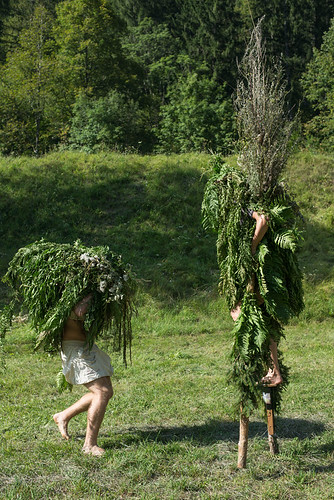
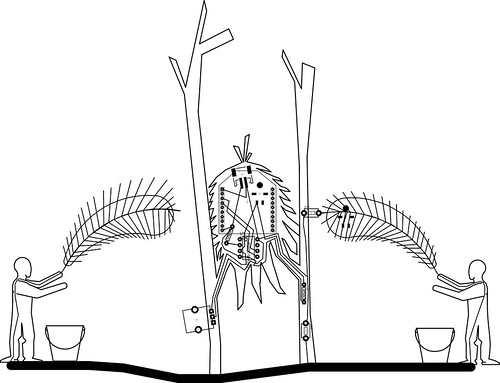
**********
http://www.kobakant.at/?p=1107
" Human Nature is a ritual, a persistent conversation between what we perceive ourselves to be and where we feel we belong.
Technology is part of us, the result of our desire to shape the environments we live in.
With this ritual we try to resolve our struggle between our love for technology while at the same time wanting to enjoy nature without distroying it or abusing it. "


**********
¶ Cyborganics by Raune Frankjaer - Sympoietic Technology -
http://frankjaer.de/cyborganics/
http://pure.au.dk/portal/da/persons/id(1c5296bf-db78-45b6-afa3-f2c7777cd41a).html
" The Cyborganics Project is a weird – and wonderful – creature.
The Cyborganic is a fantasy, a design fiction, living in a world where technology is not cold, hard, and dead, but warm, soft and alive.
A human-machine-nature hybrid of organic augmentation. A temporal assemblage, where old wisdom and future vision can meet.
Human and nonhuman.
(...)
The Bamboo Whisper is a sympoetic device. It lets us experience otherness of being. "
> video
**********
http://frankjaer.de/cyborganics/
http://pure.au.dk/portal/da/persons/id(1c5296bf-db78-45b6-afa3-f2c7777cd41a).html
" The Cyborganics Project is a weird – and wonderful – creature.
The Cyborganic is a fantasy, a design fiction, living in a world where technology is not cold, hard, and dead, but warm, soft and alive.
A human-machine-nature hybrid of organic augmentation. A temporal assemblage, where old wisdom and future vision can meet.
Human and nonhuman.
(...)
The Bamboo Whisper is a sympoetic device. It lets us experience otherness of being. "
**********
¶ RADICAL MATTERS
- Rethinking materials for a sustainable future -
written by Caroline Till and Kate Franklin
published 8 March 2018 by Thames & Hudson
1. Today’s Waste, Tomorrow’s Raw Material – Can we use industrial waste streams as tomorrow’s raw material?
2. Natural Assets – Can we find new applications that minimise waste of natural resources?
3. Shit, Hair, Dust – Can we reimagine human and animal detritus as a sustainable raw material?
4. Material Connections – Can design connect communities and promote the exchange of ideas?
5. Co-Creation – Can digital fabrication enable us to manufacture on demand with minimal waste?
6. Designed to Disappear – How can disposable products be redesigned to leave no trace?
7. Living Materials – Could living materials be grown in labs, becoming the factories of the future?
8. Future Mining – What will we mine in the future as a result of human impact on the planet?
- Rethinking materials for a sustainable future -
written by Caroline Till and Kate Franklin
published 8 March 2018 by Thames & Hudson
1. Today’s Waste, Tomorrow’s Raw Material – Can we use industrial waste streams as tomorrow’s raw material?
2. Natural Assets – Can we find new applications that minimise waste of natural resources?
3. Shit, Hair, Dust – Can we reimagine human and animal detritus as a sustainable raw material?
4. Material Connections – Can design connect communities and promote the exchange of ideas?
5. Co-Creation – Can digital fabrication enable us to manufacture on demand with minimal waste?
6. Designed to Disappear – How can disposable products be redesigned to leave no trace?
7. Living Materials – Could living materials be grown in labs, becoming the factories of the future?
8. Future Mining – What will we mine in the future as a result of human impact on the planet?